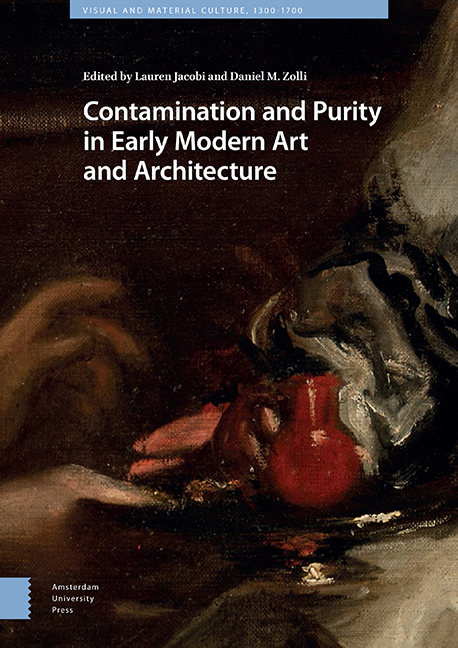Book contents
- Frontmatter
- Contents
- List of Illustrations
- Introduction: Contamination and Purity in Early Modern Art and Architecture
- 1 Generation and Ruination in the Display of Michelangelo’s Non-finito
- 2 The Sacrilege of Soot: Liturgical Decorum and the Black Madonna of Loreto
- 3 Sedimentary Aesthetics
- 4 ‘Adding to the Good Silver with Other Trickery’ : Purity and Contamination in Clement VII’s Emergency Currency
- 5 Tapestry as Tainted Medium: Charles V’s Conquest of Tunis
- 6 Bruegel’s Dirty Little Atoms
- 7 Leakage, Contagion, and Containment in Early Modern Venice
- 8 Contamination, Purification, Determinism: The Italian Pontine Marshes
- 9 Colonial Consecrations, Violent Reclamations, and Contested Spaces in the Spanish Americas
- 10 Contamination | Purification
- Index
3 - Sedimentary Aesthetics
Published online by Cambridge University Press: 27 May 2021
- Frontmatter
- Contents
- List of Illustrations
- Introduction: Contamination and Purity in Early Modern Art and Architecture
- 1 Generation and Ruination in the Display of Michelangelo’s Non-finito
- 2 The Sacrilege of Soot: Liturgical Decorum and the Black Madonna of Loreto
- 3 Sedimentary Aesthetics
- 4 ‘Adding to the Good Silver with Other Trickery’ : Purity and Contamination in Clement VII’s Emergency Currency
- 5 Tapestry as Tainted Medium: Charles V’s Conquest of Tunis
- 6 Bruegel’s Dirty Little Atoms
- 7 Leakage, Contagion, and Containment in Early Modern Venice
- 8 Contamination, Purification, Determinism: The Italian Pontine Marshes
- 9 Colonial Consecrations, Violent Reclamations, and Contested Spaces in the Spanish Americas
- 10 Contamination | Purification
- Index
Summary
Abstract
Around 1530 artists began painting on stone. Early on artists mostly used slate, though toward the end of the sixteenth century they began painting on various kinds of semi-precious stones like lapis lazuli. Such pictures were appreciated for how the pure lithic material was augmented by the painter. In the seventeenth century, artists (especially in Florence) began painting on a particular kind of sedimentary stone known as pietra d’Arno that subverts this aesthetic. Unlike semi-precious stones whose material splendor and purity lends itself to aesthetic appreciation, this stone is unrelentingly base: pietra d’Arno is essentially solidified mud. This essay investigates how artists used this sedimentary substrate to support ethical investigations of humankind's position as fallen beings in the created world.
Keywords: sediment, painting, geology, ecology, pietra d’Arno, lapis lazuli
As practiced in early modern Europe, painting was closely intertwined with geological pursuits. By 1500, most Italian paintings were created using an oil-based medium in which microscopic fragments of color were suspended in a mixture of linseed oil and other additives. Some pigments were derived from organic matter, principally the particularly intense shade of red that was taken from the desiccated corpses of cochineal bugs, from which it takes its name. However, the vast majority of pigments were produced by manipulating various minerals. Early modern artists obtained some pigments from metals; verdigris, for instance, is derived from copper alloys, which produce a green patina when brought into prolonged contact with acidic compounds. Others, like ultramarine, are made from pulverized stones, in this case lapis lazuli. When considering the geological heritage of painting, we do well to remember that prior to Linnaeus's reorganization of taxonomy both rocks and metals were considered different species under the same category: ‘fossil,’ which encompassed essentially all things that came out of the ground. Indeed, the Latin term fossilis simply means ‘dug out of the ground.’ Pliny, the author of the most important ancient discussion of painting, took seriously the geological origins of painterly materials: his discussion of painting is embedded in a chapter that discusses various kinds of stone, making clear that painting is an epiphenomenon of stone. This is a point that pre-modern artists rarely forgot, and recovering the linkage between painting and the sediments of geology changes our perspective on early modern art history.
- Type
- Chapter
- Information
- Contamination and Purity in Early Modern Art and Architecture , pp. 129 - 156Publisher: Amsterdam University PressPrint publication year: 2021

